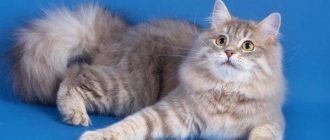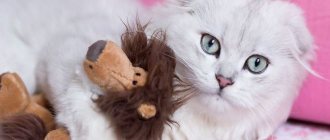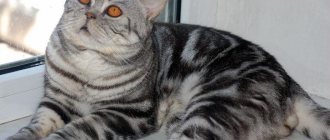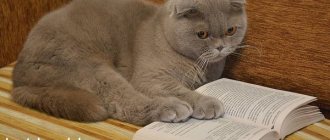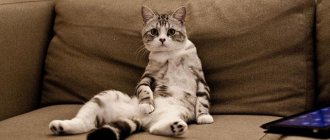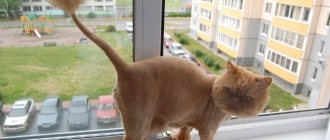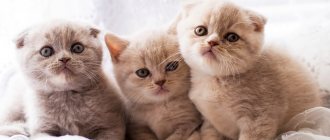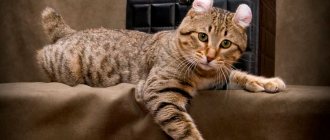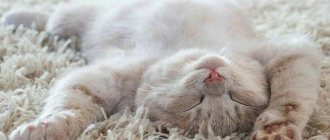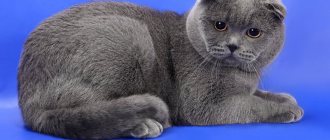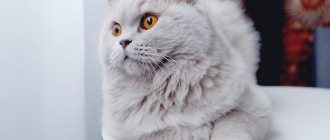A fluffy cat sits with its paws spread out imposingly, the only thing missing is the TV remote control. Straight ears and wide open eyes with a silent question. A Highland Straight representative of one of the four breeds of Scottish cats has settled at home. The pet differs from its relatives in the length and thickness of its fur, and, like a true Straight, is considered to have upright ears. What features do these animals have and how not to make a mistake when choosing a kitten: just find out the requirements of the standard and the recommendations of breeders.
Maintenance and care
Highland cats are very clean and have fairly good health.
They tolerate cold well, do not like heat. Particular attention should be paid to their tray and eating utensils; these aristocrats love cleanliness. There are no special recommendations to maintain good health; vaccinations and good food will be enough
They are relaxed about bathing, but you should not bathe them too often; once every three months will be enough. Wash with products intended for long-haired cats. Then dry them with a hairdryer using warm air.
It is advisable to feed Highland Straight with food for purebred cats. These foods are of higher quality and are made from expensive bases. They should include all the necessary vitamins and nutrients. Although Straights are in good health, they are often calcium deficient. You need to be careful with cheap food; there are a lot of fakes and low-quality products among them.
You should not leave a lot of food in the bowl at once; cats are prone to overeating. When feeding food, do not forget to monitor the availability of water. These cats are not against natural food, but it takes more time and effort.
The normal human diet is not acceptable for them, and health problems may arise. For details about feeding, you should contact the breeders; a sudden change in diet can adversely affect health.
Breed defects
Since the breed is quite young and not numerous, its gene pool is limited, and if the rules of breeding are violated, both hereditary health problems and some phenotypic deviations from the standard can arise.
Tendency to diseases
Straight-eared Scottish cats are distinguished by enviable health and, if kept in good conditions, live up to twenty years without problems. The main problems can be various anomalies of bones and joints, caused by both poor heredity and improper cultivation.
The basis of most of these ailments is often a genetic pathology, fixed in the process of illiterate or unscrupulous breeding work. Unfortunately, such diseases can rarely be completely cured. However, the sooner they are diagnosed, the higher the likelihood of maintaining the animal in normal physical shape.
A common breed problem is poor mobility of the spinal joints. Show experts pay special attention to the cat's topline when moving: it should be level and stable. A cat can be removed from the show if its joints crack or squeak - this is considered a disqualifying fault, indicating poor genetics - such animals should not be bred.
Among the breed diseases of Straights there is even dysplasia of the hip and elbow joints - a pathology that is generally extremely rare in cats. A reliable diagnosis of the disease is provided by correctly taken x-rays of an animal that has reached one year of age. The veterinarian will prescribe treatment or supportive care depending on the degree of dysplasia. In some difficult cases, surgical intervention is indicated.
The consequence of an unbalanced, too abundant and high-calorie diet is obesity characteristic of the breed and associated diseases of the cardiovascular system.
Flaws in appearance
The breed standard pays special attention to the Straight's ears - they should not be large or even slightly sagging. Such shortcomings automatically prevent the animal from participating in the exhibition, and therefore in breeding. A serious drawback is considered to be “wadding”, matting and tangling hair, as well as long tufts of it on the eyebrows or other parts of the head. Cats with any abnormalities in the structure of the bones or joints will not receive high expert ratings; weighted animals.
Disqualifying faults include a tail that is too short and stiff, a hook at its tip, and an unusual number of toes on the paws. The animal must be healthy and move easily and harmoniously.
Video: Highland Straight kitten at an exhibition
Care and maintenance
Procedures necessary to maintain the health and comfortable living of a Highland Straight family:
| Bathing | Combing | Going to the doctor | Eye treatment and ear cleaning | Nail cutting |
| Once a year or when soiled, after a walk, immediately before the exhibition | Once a week, every day during shedding period | At the first signs of illness and on schedule (check with your veterinarian for vaccination times) | Once a week | Use small nail scissors once a week, being careful not to touch the skin around the claw. |
Caring for a Scottish Straight cat with long hair is different from caring for short-haired cats. First of all, the size and thickness of the coat without proper combing will become a problem for everyone living in the house. The procedure is performed with a special comb; during the molting period, the need for combing the fur increases.
https://youtube.com/watch?v=UF-uM5FV-3M%3F
You may be allergic to Scottish fur, symptoms of an allergic reaction to cat hair:
- redness of the eyes;
- edema;
- itching
If symptoms appear, you should consult a doctor and get tested.
Straight-eared Scots can be on a natural and mixed diet, as well as receive exclusively factory-made food. Some animals eat natural food for up to 6 months, sometimes commercial feed. After six months of life, pets are completely transferred to the dry variety.
Veterinarians advise to refrain from purchasing cheap food. Cats usually quickly get used to them and love them because of the presence of flavor enhancers. But this is detrimental to the health of pets and negatively affects the appearance of the crumbs’ fur. And in the future, difficulties are observed when switching to more expensive, but high-quality food.
To preserve furniture and walls, cats must be trained to use a scratching post. If the baby does not get used to the device and scratches the surface in the house, it means that the animal was taken away from the cat too early and was not raised.
Rules that must be followed by family members after the arrival of a purebred pet at home:
- You cannot leave the balcony door and window open; a curious animal may fall out of the apartment. It happens that if a cat falls from the 10th floor, it will only get away with fright. But most often, flying even from the third floor will cause injuries and bruises to the pet that are incompatible with life.
- Do not leave the window and door in the microclimate. The baby can get stuck in a narrow gap and die.
- Do not allow a purebred cat to roam freely. Often, owners find a cat left unattended on the street, torn apart by dogs.
- Care must be taken to ensure that the animal does not swallow a foreign object. Due to the structure of the tongue, the cat cannot spit out the thread or rain (Christmas tree decoration), the eaten bag will cause the cat to appear on the surgical table. Since, by pulling the insides of the intestines, the rope creates conditions for food obstruction, and the baby dies if medical assistance is not provided in time.
This fluffy handsome guy is not only a cute toy, it is responsibility and care.
Feeding the cat
The health and life expectancy of the Highland Straight largely depends on the quality of nutrition. The cat's diet should contain enough vitamins, microelements and protein, which contributes to the formation of muscle mass.
Complete diet
Breeders recommend feeding Highland Straights with ready-made premium or super-premium dry formulas. Industrial feeds are properly balanced and contain meat, grains, vegetables and vitamin supplements. However, some cat owners prefer to create their own diet from natural products.
In this case, you need to include in the Highland Straight menu:
- lean meats - rabbit, turkey, veal, chicken;
- offal – heart, chicken gizzards, liver (once a week);
- sea fish;
- cereals – rice, oatmeal;
- vegetables and herbs;
- low-fat cottage cheese, yogurt, kefir;
- eggs.
The cat should not be fed pork, lard, or potatoes. Salty, spicy foods, sweets, bread and processed foods, as well as bones are strictly prohibited.
Feeding frequency
Adult cats are fed 2 times a day - morning and evening. At lunchtime, you can treat the Highland Straight to a piece of cheese or other delicacy. It is very important that clean drinking water is always available.
Kittens eat more often because their metabolic processes proceed faster. Babies up to 3 months are fed 5-6 times a day. Next, the pets are transferred to a four-time diet. From 6 to 9 months, food is distributed 3 times a day.
Vitamins and minerals
When feeding Highland Straights with natural food, the risk of developing vitamin deficiency increases. After all, it is impossible for a non-specialist to create a diet so that the cat receives all the necessary substances in the right quantity.
For this reason, veterinarians recommend feeding Scottish longhair cats with vitamin and mineral preparations 2 times a year.
How to care?
These animals are gentle creatures, but cats do not require particularly complex care. It is necessary to vaccinate from time to time, apply antiparasitic agents to the fur, which will be prescribed by the veterinarian, and also check the animals for the presence of worms, ticks and fleas. If any illness is detected, the cat should be taken to a veterinarian.
Long-haired Scots do not shed very much, but cats still need to comb their fur with a special brush about 3 times a week. With this you can rid your pet of unnecessary fur, and the animal’s blood circulation will also improve. If the shedding period begins, you need to use a slicker brush.
This breed can be bathed no more than 4 times a year. You need to know that this breed is very sensitive, so you can’t use regular shampoos, as they can cause allergies in cats. For animals you need to purchase special shampoos that soften the fur. After bathing, the pet should be dried with a hairdryer.
Highland Straight
It is unpretentious in care. She feels good at home, so she practically never leaves the house. If the pet owner wishes to take his animal for a walk, the walk should be postponed until cloudy, cool weather. This breed does not tolerate heat well.
Scottish cats love to be alone, so they need to have a sleeping area. A scratching post with a bed or a closed house can be used for this.
Hygienic procedures include the following actions:
- Scottish cats need to wipe the fur around their eyes;
- if dirt appears on the ears, they need to be cleaned with a damp cotton pad;
- pets need to brush their teeth about 2 times every 7 days;
- Trim nails monthly.
Highlands are clean cats, so their litter box should be kept away from their food bowl. The cat's toilet area can be the bathroom. Cats should have constant access to their litter box, so room doors should always be open.
You need to buy litter with large granules, as small ones can stick to the fur. For cats, you can purchase absorbent or clumping litter. No need to purchase scented products. Due to excess odors, animals will not go to their toilet. The filler needs to be changed from time to time, and the tray itself needs to be cleaned.
Highland Fold
This pet must be accustomed to the tray, carrying and hygiene procedures from a young age. Cats and cats feel good at home, but they need to allocate a space where the mattress will be located.
For small kittens you need to purchase toys such as a mouse, a ball, and a small fishing rod. Toys should be safe and free of toxins.
There is no need to let cats out on their own. Before walking your cat, you need to vaccinate your pet and spray it with a special spray that protects against fleas.
The coat of this breed is amazing, but you don’t need to wash the animal often, just brush it. When shedding occurs, you can use a furminator. You need to bathe a cat of this breed using a special shampoo that is designed for such pets.
If your pets have tears in their eyes, plaque on their ears, and discharge from their nose, this is a sign of illness. In this case, you need to take your pet to a veterinarian. For prevention, the nose, ears and eyes should be periodically examined and cleaned of secretions. The inner corners of the eyes should be wiped every other day. For this procedure, you need to use clean cotton pads with a cat eye care product. Do not wipe your eyes with dry cotton wool.
If a slight inflammation occurs, you need to use disinfectants - hydrogen peroxide, chlorhexidine, boric acid. The ears should be cleaned with a cotton pad, but it is forbidden to insert the cotton pad deep into the ear, otherwise the animal will be injured. Each time you need to use a clean cotton pad.
The claws need to be trimmed carefully; for this procedure, special tweezers are used, which can be bought at a pet store. The claws will not peel, and the tweezers will not carry an infectious disease. The claws that are located on the front paws must be trimmed once every 14 days, on the hind paws - once a month. Do not use regular scissors to trim nails as this may cause injury to your pet.
These purebred cats do not have any hereditary diseases, but they can develop rickets. It may appear due to calcium deficiency. Cats need to be given food that contains it in sufficient quantities.
Tendency to diseases
Scottish breed pets cannot be classified as sickly animals. But still, there are certain pathologies that are typical for such cats. The main problem is joint diseases - the lop-eared gene, which makes animals' ears look so unusual, can negatively affect the condition of the musculoskeletal system. True, Scottish straights and highland straights do not have this problem.
A predisposition to some pathology does not necessarily mean that the disease will manifest itself. A loving owner should simply be aware of possible problems in order to take appropriate measures in time. Some of the following pathologies are characteristic of “Scots”, while others can develop in pets of any breed:
Osteochondrodysplasia. The pathology is incurable; specialists prescribe only supportive therapy that can significantly improve the pet’s quality of life. The disease manifests itself as lameness, slow growth, and deformation of the limbs. The tail of animals with this problem is usually short, has low mobility and is thick. The pet has difficulty walking, jumping up and jumping off. The cat is prescribed chondroprotectors and anti-inflammatory drugs - they relieve pain. In some cases, surgical intervention is resorted to. Cardiomyopathy. When sick, lethargy, shortness of breath, and cough may occur. Typically, pets with this pathology are developmentally delayed. The doctor can determine the problem during the next examination. In addition to therapy prescribed by a specialist, your pet must be protected from stress, and taurine supplements must be included in the diet. Urolithiasis disease. It occurs 5 times more often in males than in females. The pathology is manifested by pain when urinating and the appearance of blood in the urine. Your pet may lick the genital area frequently. The first aid that can relieve pain is to apply a heating pad to the stomach. The heat will relieve the spasm and the animal will feel better. With such a problem, you cannot delay visiting the veterinarian. Discharge from the eyes. If they are transparent and not very abundant, this is normal. If they are green, yellow or red, this is a reason to contact a veterinarian. The cause of colored discharge may be infection, worms or low immunity. Obesity. “Scots” are prone to excess weight, but whether the pet becomes obese depends entirely on the owner. Following the principles of proper nutrition will help maintain the animal’s normal weight. Ringworm. Even a pet is at risk of getting sick - spores can be brought into the house by one of the household members on their shoes. Symptoms of the pathology are hair loss, itching, and spots on the skin. Therapy includes the use of Clotrimazole or Miconazole ointment. Good results are obtained by bathing with Nizoral shampoo and injections with Vakderm or Microderm. In severe cases, Griseovulfine tablets are prescribed.
It is important, until the problem is resolved, to carry out regular and thorough cleaning of the house, as well as limit contact with animals, because the disease is also dangerous for humans.
Our Scottish kitten had ringworm. Unfortunately, we discovered the problem late, which led to infection of all family members. The child was especially affected - he was covered all over with spots: lichen was on his face, hands and even on the scalp. The treatment was very long - the child’s affected areas were treated 4 times a day alternately with sulfur ointment, iodine, and the drug Exifin. The animal was helped by the drug Vakderm - after two injections every two weeks, all signs of lichen disappeared.
Timely vaccination, deworming of your pet and periodic examinations by a specialist will help prevent the development of many serious pathologies.
Caring for a Scottish Longhair cat
The fragile appearance of Scottish Highland Straights is very deceptive - they have very good health. For the most part, all the owner has to do is timely vaccinate the animal and treat it to prevent possible parasite infection. In the future, you will need to make regular visits to the veterinarian and follow a preventive schedule for ticks, fleas, and worms.
Grooming
Despite its length, caring for the coat of a Scottish longhair cat is not as difficult as it might seem at first glance. First of all, because Highland Straights practically do not shed. To solve the problem with their fur, simply brush them with a special brush during the molting period.
The animal also needs to be bathed once every few months, its claws trimmed and its ears cleaned regularly. When bathing, it is better to use special shampoos so that the coat does not lose its famous shine. It is strongly not recommended to use human products to wash your cat - this can provoke an allergic reaction and dermatitis.
Dry the cat using a hairdryer, but you need to keep it at a distance of 30-40 centimeters from the animal. If this is neglected, it can subsequently lead to various diseases in the animal and even its death as a result of overheating. You can comb your Highland Straight at least once a week, maybe twice.
When combing, special attention should be paid to the collar and belly areas.
Highland Straight cats
Watch this video on YouTube
Highland straight nutrition
For nutrition, it is recommended to use either well-selected natural food or professional food. Under no circumstances should the animal eat human food - this can threaten the cat with serious problems with the stomach, bladder, and kidneys. When selecting food, you should always remember that Highland Straights have a calcium deficiency, which must be included in their diet. Otherwise, the cat may have problems with the musculoskeletal system.
Scottish cats: features and care. Cat breeds. Give Paw
Watch this video on YouTube
Features of care
Although the Highland Straight breed is a long-haired breed, caring for its coat does not require as much time and effort as in the case of Norwegian forest cats .
In the photo their fur looks simply gorgeous.
The cat care package includes:
- washing (once every few months is enough);
- combing with a furminator ;
- nail trimming;
- ear cleaning;
- teeth cleaning.
Before putting your cat in the bath, you need to clean her ears, trim her claws and comb her hair.
When brushing, it is recommended to pay special attention to the fur on the belly, around the neck and hind legs.
Washing Highland Straight
A layer of degreasing paste is applied to the prepared dry wool and massaged for about five minutes.
Wash off with warm water. Next, take a shampoo designed specifically for semi-long-haired cats.
This product will gently clean the coat without weighing down the hairs, and will highlight the advantages of the breed.
Important! All shampoos must be thoroughly rinsed with water, otherwise dust particles will stick to the remaining product and the appearance will become untidy.
Well-groomed coat is an indispensable condition for photos
The final stage of washing is the application of texturizer.
This is a special balm that gives volume to the coat, prevents hair from matting and has an antistatic effect.
At the end, all that remains is to dry your pet’s coat with a hairdryer.
It is advisable to use a device with warm air for this.
It should be kept at a distance of at least 40 cm from the animal to avoid overheating.
Do not frequently dry the animal's fur with a stream of hot air.
This leads to dehydration, brittle hair and lack of shine.
If the animal is not washed regularly, after washing off the degreasing paste, apply a super-cleaning shampoo.
It is distributed over the fur with massaging movements. Then wash off with water.
Caring for animals that participate in exhibitions and often pose for photos has certain differences.
When choosing products, you need to choose shampoos that do not contain oils.
At the same time, products containing a small amount of nourishing oils are perfect for home care for your pet.
They nourish the fur coat and will be especially effective in the cold season.
Although at first glance washing a Highland Straight cat may seem complicated and time-consuming, in practice it only takes 30-40 minutes.
As a result, the fur is well-groomed, does not fall off and does not remain in the form of tufts on the furniture or clothes of the owners.
Important! You should not use products intended for humans to wash your cat, as allergic reactions may develop.
Kittens have long, silky fur
Combing
The Highland Straight breed has a semi-long, flowing coat.
It doesn't look cottony like Persians and is much easier to comb.
In fact, caring for your pet’s fur coat is not at all burdensome; daily brushing is not required.
It is enough to brush your cat just once a week.
If she likes this procedure, of course, this can be done more often.
Walk
A Highland Straight cat can sometimes be walked on a harness, especially in freshly fallen snow.
It is recommended to regularly ventilate the room where the pussy lives.
It is worth considering that these animals do not like heat.
The optimal temperature for keeping them is from 18 to 21 degrees.
Nutrition
There are two options for feeding a Highland Straight cat:
- professional feed;
- food prepared by the owners, but here you need to carefully consider the diet, give special supplements and vitamins.
The first option is preferable - it is better to use a diet for elite breeds.
Such a balanced menu will maintain your pet’s health and provide its body with all the necessary substances.
There are quite a few super-premium cat foods out there.
These are brands such as Almo Nature diet, Bozita, Grandorf, Brit .
Origin of the Highland Straight breed
When the snow-white beauty Susie was born on a farm near the Scottish town of Coupar-Angus with ears deformed by a natural mutation, she was left in the house because of her unusual appearance. She is the ancestor of all Scottish cats.
Later, one kitten from Susie named Snooks (a girl) was given to the owner of a neighboring farm, William Ross, who had a British cat with absolutely normal erect ears living with him in full allowance. The “bride” Snooks had her mother’s ears - curved forward and down.
The kittens of this couple inherited both their father's and mother's ears.
William found this heredity funny, and he handed over the cat children to familiar breeders in Foggy Albion. There they reacted coolly to such an interesting anomaly in the development of ear cartilages and willingly transferred all matters into the hands of breeders in the United States of America.
American breeders greeted the fold-eared “Scots”, and their differences from the British, warmly and joyfully and immediately began to form a new breed out of them. For this purpose, short-haired American cats and cats, as well as “British” ones, were brought in.
It should be recalled that the British Shorthair cat has the blood of Persian (Iranian) longhair cats, so it is not surprising that some Fold cats have acquired long Persian hair. This is how the breed of semi-longhaired Scottish with plush ears appeared - the Highland fold.
Breeding
In breeding, a cat is no less difficult than its closest relatives.
This should be done by a specialist; an ordinary amateur cannot do it. It is necessary to strictly observe and double-check all lines allowed for breeding, otherwise you can end up with a sick animal with skeletal deformities and various diseases of the joints and muscle tissue.
In any case, breeders are advised to cross pointy-eared Straights with Scottish Folds. In this case, the kittens turn out like beads from different necklaces: all as one - plump, round and dense, but the length of the fur and the placement of the ears are different.
But, even if all the recommendations and strict rules are followed, the percentage of future “culls” is very high, which is why cats of this breed are so rare at our exhibitions.
Health
Scottish cats are physically strong animals.
They tolerate cold well and are resistant to infections.
However, these animals do not like heat.
To maintain a comfortable microclimate in the place where they live, you can use humidifiers.
Vaccinations
The first vaccination is given to a kitten at the age of 7-9 weeks.
In accordance with the instructions for the drug, revaccination is carried out after 2-3 weeks.
Kittens are vaccinated annually. In the second year, vaccination will need to be done after 11 months.
Vaccination is carried out only on healthy animals.
Deworming is carried out 14 days beforehand.
If the animal shows signs of illness - cough, poor appetite, vomiting and any other disturbances - the vaccination is canceled.
The vaccine will only make the condition worse. First you need to treat the cat, and only then vaccinate it.
If the animal has been ill 3-4 months before the procedure, only inactivated vaccines should be used.
The use of specialized medications will prevent relapse of the disease.
And one more reminder - the better the conditions in which the cat is kept, the less likely it is that it will get sick.
Health status
Scots are born in good health. No genetic abnormalities in development were found. If the maintenance rules are followed, Scottish representatives live 12-20 years.
The color of the eyes and fur of cats can be different.
Tendency to diseases
Due to their lack of mobility, Highlands easily gain excess weight and this can lead to problems with the spine and musculoskeletal system.
In order to maintain the health of your pet, it is imperative to vaccinate it, doing this annually. There are two mandatory types of vaccines.
Antiviral and anti-infective against such diseases:
- rhinotracheitis;
- panleukopenia;
- calicivirus;
- chlamydia;
- rabies.
If there are other pets living in the house, it would be a good idea to add vaccinations against:
- ringworm;
- coronavirus;
- viral leukemia;
- infectious peritonitis.
Important! Half a month before vaccination, the animal must be treated for worms.
The start of vaccinations depends on the kittens' lifestyle. If they are nursed by their mother, antibodies protect them through milk. Artificial or weaned kittens should begin to be vaccinated at 2.5 months of age.
Varieties
Highland Fold Fold. In appearance, these pets may look very large, but in fact they simply have too fluffy fur and a large bone. Therefore, these pets are not obese or overweight. Cats of this breed have the following characteristics.
- The head is round, medium in size, with a chin, cheeks and jaw located on it.
- The body is short and proportional to the head. The paws are small, round in shape, and look too furry. The weight of an adult pet can reach 7-8.5 kilograms.
- A cat has a distinctive feature - its ears. They are always folded. The ears have single, double, sometimes triple folds that determine their shape. When kittens reach the age of 3 weeks, their folds are already visible. Ears are the main characteristic that determines the thoroughbred of a pet.
- The eyes are set wide and large. They are round in shape, so they fit well with the roundness of the pet. The shade of the eyes matches the shade of the fur. All parts of the face give the cat a surprised expression.
- The cat's fur is very soft, light and silky to the touch. The hind legs and chest have longer fur.
The color of the coat can be varied, but it will not have white spots and it will not have lilac and chocolate undertones. There is such a color as color point - the pet’s body color has light tones, and the paws, tail and muzzle have dark shades.
The color of a cat's fur can be solid, striped, or spotted. The rarest thing you can come across is a marble shade. The most popular are tortoiseshell, gray, smoky, white and black coat tones. There are representatives of the breed that have colors such as bicolor and tabby.
The rarest coloring is “turtle in patches”. This color can only be found in females. It appears thanks to a combination of tortoiseshell and bicolor. In this case, the animal’s body will have 3 colors. The lower part of the body will have a light shade, and the upper part will have a tortoiseshell tone.
The straight-eared, fluffy Highland Straight is a rare breed, so such cats can only be seen at exhibitions and in special nurseries. These animals have close relatives - Persian and British cats. Thanks to this, the animal has fur of a rare color. The distant ancestor of these breeds is the wild cat, which lived in the 18th century in the mountains of Scotland.
This breed is usually bred by crossing a Highland Straight with a Highland Fold. If you use a female and a male from the same breed, a genetic pathology may develop. Crossbreeding may result in kittens that have both erect and drooping ears.
The long-haired cat has a massive but small body. Its weight varies from 4 to 6 kg. The head has a round appearance, the plump cheeks protrude slightly. The forehead is wide, has a small notch near the nose. Animals' eyes are set wide apart. The fur is long, silky, and has many color options, each of which can match the eyes.
The ears are medium in size, with rounded ends. The pet has thick paws, so it appears plump. But the body itself is not thick, it has average dimensions.
Brief history of the breed
The history of the Scottish Straight cat began in 1961 in Scotland. At that time, the owner of a small farm discovered a fold-eared kitten in the litter of his pet. It was a cat who was named Susie.
She became the progenitor of the fold-eared and straight-eared long-haired Scottish. Breeders infused her descendants with the blood of Persian and British cats. As a result, 2 varieties appeared - Scottish Highland Straight and Scottish Highland Fold. The first has straight ears, and the second has folded ears. The breed was recognized in 1970.
Nutrition
A purebred pet most often arrives at a new home already accustomed to dry food. At first, the baby must eat what he is used to from the breeder. If you suddenly change the diet of a Scottish Highland Straight kitten, he may get sick. If the owners are not satisfied with the food that the breeder has chosen, then they must wait until the end of the baby’s adaptation to the new home.
Veterinarians recommend feeding Scottish cats with premium food, for example, Royal Canin or Hills. They already contain all the vitamins and minerals the animal needs. If owners plan to feed their pet natural food, they should create a diet of dietary meat, vegetables and dairy products. Additionally, owners should purchase high-quality vitamins. It is impossible to feed food from the table of a Scotsman, this will negatively affect his health.
Feeding
Highland Straights are not picky eaters, but it is easiest to keep them on premium dry food. They are balanced, that is, they contain everything you need.
If natural nutrition is meant, then the menu should include:
- dietary meat (beef, rabbit, chicken, turkey);
- cereals (buckwheat, rice);
- kefir (ryazhenka, yogurt);
- greenery;
- vegetables;
- vitamin supplements.
Food from the table is strictly not recommended. The meat should be scalded with boiling water before serving. And under no circumstances should you give cow's milk.
Interesting! These pets never beg for food. They will wait patiently until the owner takes care of them.
Peculiarities
Representatives of this breed are original and beautiful. The cat has its own distinctive features. She has a muscular build and strong limbs. Females weigh less than males, weighing about 5.7 kg. The tail of cats is long, mobile and proportional to the body.
The muzzle is rounded, the profile is smooth, the cheeks are plump, the cheekbones do not have sharp shapes. Males have too full cheeks. Their chin does not protrude, their neck is short, their ears are narrow and of medium size. If the ears are large or recumbent, then this is a breed defect. The coat color and eye color match. The nose of these animals is short and has a slight deflection.
Almost all varieties of coat color are considered standard: bicolor, harlequin, spotted, solid, harlequin, brindle, etc. Unlike other breeds, Scottish cats have a huge range of colors in their coat. The hairs are dense and do not adhere to the body. If the wool feels like cotton wool to the touch, then this is also a disadvantage.
Description
The graceful Scottish Straight has several features in its appearance that are characteristic only of this breed. Yes, the description of the standard for straight-eared cats differs little from Scottish ones, but dry facts are not always objective.
It is hardly possible to convey the feeling of foamy silkiness in your hands and trusting surprise in your eyes. In addition, the overall stockiness of the figure of these cats is transformed into a graceful and flowing silhouette due to the fluffy long hair.
The Highland Fold Standard assumes that a purebred representative of the breed will meet the following description:
- body. The sizes are average. The weight of an adult cat is up to 5 kg. Cats are a little smaller. The body is large. Short legs make this breed stocky, but do not diminish its grace. The cat has a developed muscular constitution, a short and powerful neck. The tail is usually of medium proportions and not long;
- head. The breed has a rounded head with prominent, full cheeks. Well formed lower jaw; not protruding, but noticeable chin. The nose is straight and fairly wide. The vibrissae pads are clearly visible on the cat's face;
- ears. Heavily pubescent outside and inside. Set wide apart, small and graceful, distinguished by a wide base and neatly pointed tips. Must be straight, otherwise the animal will be rejected;
- eyes. Round and large, quite widely spaced. Slanting is excluded. Eyes can be of any color, provided they are in harmonious combination with the natural color of the cat;
- wool. A distinctive feature of the Highland Straight is its luxurious silky coat. The average length of the guard hairs corresponds to the height of the dense undercoat. The structure gives the fur additional volume; in the light it is glossy and does not cling. Cat colors are acceptable in any variations and combinations.
The straight-eared long-haired Scottish is a desirable pair for mating with the Highland and Scottish Folds. Such unions improve blood health and prevent irreversible degeneration of the gene pool of these cat breeds.
In the offspring of such couples, kittens are born with both straight and curved ears. This does not appear immediately - only in the 3rd week. In addition, long-haired and short-haired kittens can appear in one litter in all the variety of colors inherent in the breed.
Interesting Facts
The long-haired straight-eared cat got its name from the mountainous terrain in Scotland, where the breed originated. The word highland translated from English means “highlands”.
Other interesting facts about Highland Straights:
- These cats have a poorly developed vestibular apparatus. When falling from a height, they do not always land on their feet. Scottish Longhairs are afraid when they are picked up and never climb to heights themselves.
- The Highland Straight gene for long hair was inherited from representatives of the Persian breed.
- Both straight-eared and fold-eared longhaired Scots are used to work with children with special needs. They are present in school classes in some European countries.
How to choose a kitten
Choosing a kitten is not an easy task
You need to pay attention to the following aspects:
- appearance;
- behavior;
- health status.
When choosing a kitten, you should pay attention not only to its photo, but also to watch it in person. An important indicator is the condition of the coat: it should be shiny and smooth.
An important indicator is the condition of the coat: it should be shiny and smooth.
The tail should be mobile to the very tip, without deformed vertebrae.
It is important to observe the kitten's behavior. A healthy baby is active, playful and curious
A healthy baby is active, playful and curious.
His mood and attitude towards people are also important. If he is wild and does not make contact with people, there is a chance that his behavior will not change in his new home.
If he is wild and does not make contact with people, there is a chance that his behavior will not change in his new home.
This breed is rich in different colors
Health status
The next point is health.
There should be no discharge around the kitten's eyes or nose.
The baby itself should be strong enough and well-fed, the coat should be smooth and shiny.
A bloated tummy, dull and disheveled fur coat are signs of either a disease or poor nutrition.
You also need to make sure that the kitten does not have bad breath.
A healthy baby will smell nice of milk.
There should be no brownish coating in the ears, which may be the result of ear mites.
Conditions of detention
You need to inquire about both the condition of the kitten and the peculiarities of its maintenance.
It is worth asking the breeder about his diet.
A sudden change in diet causes health problems, so it is better to leave the menu unchanged.
You need to look where the tray is located and find out what kind of filler the breeder uses.
Social adaptation is important for kittens
Another point when choosing kittens is getting to know their parents.
After watching them, you can imagine how the kitten will most likely grow up.
You should ask the breeder about vaccinations.
If you like one of the kittens, but its vaccination has not yet been completed, you should make an advance payment for the baby and wait until he gets all the vaccinations.
This will subsequently protect your pet's health.
Choosing a kitten
Breeders recommend not buying a Highland Straight kitten before 2 months of age. The baby must receive the necessary microelements from mother's milk, get stronger and learn self-care skills. In the nurseries, they vaccinate their children, treat them against fleas, ensure that animals are examined by a veterinarian, and select the best kittens for breeding and participation in exhibitions.
What points should you pay attention to when choosing a kitten:
- wool, it should flow, not hang in clumps like cotton wool;
- position of the ears, the ears of straight cats must stand up and fit tightly to the surface of the skull;
- The tail of a qualified animal cannot be short, with a hook at the tip. It should move well, not cause pain, and be free of thick vertebrae;
- correct number of toes.
Usually the behavior of a kitten is observed: the sick animal is active and playful. A purebred animal is considered as such when a pedigree is provided. In addition, the breeder is required to provide documentary evidence of vaccination and treatment against helminths and fleas. Many owners help with the delivery of their charges to the new owner’s home and provide recommendations and reference materials for caring for their furry pet.
Breeding
Breeding is not so easy: you need to know with whom you can breed a long-haired pet and in what period, so as not to cause painful consequences for the offspring. The Highland Straight is crossed with the Scottish Fold cat; breeding of pets with the presence of the fold gene in both partners is not allowed.
Scottish Straight Scottish Shorthair Straight cat
Scottish fold Scottish fold cat
Description of the breed and appearance
The Scottish Longhair cat is an officially recognized breed by the world organizations TICA and WCF with approved standards.
Description of the appearance of Highland cats:
- strong muscular physique;
- the average weight of cats is 3-4 kg, males - 4-6 kg;
- the limbs are strong with well-developed muscles that enable long jumps;
- long tail with luxurious coat;
- round head with smooth outlines and protruding cheeks;
- wide-spaced ears of medium size or with a curved auricle, characteristic of Scottish Folds;
- short nose with a depression in the bridge of the nose;
- large expressive round eyes, the shade matches the main color;
- The coat is long, silky, quite thick with a chic collar on the neck and noticeable pubescence on the belly.
Different coat colors are allowed, both solid and mixed combinations.
The photo shows a Scottish kitten, chinchilla color
Average life expectancy is 15 years.
Character of the breed
The long-haired Scot seems to have been born for domestic life. A calm, important cat: he will fall apart on his fifth point, folding his front paws. The reason for purchasing a white Scottish cat will be not only the beautiful appearance of the ward, but also the docile nature of the baby. Up to a year old, babies are playful and playful; as they mature, they become more sedate, but no less funny.
The habits of the Highlands resemble those of a dog. They perform simple actions:
- bring an abandoned toy,
- walk on leash without difficulty,
- They play hide and seek with each other and with the owner.
Animals of this breed are flexible and affectionate. It will not be difficult to accustom your pet to a cat litter box and a scratching post; the main thing is that the mother should be involved in raising the baby for up to 2 months. An experienced breeder will ensure that the cubs acquire hygiene skills.
Highland Straight cats easily get used to a new place; you need to observe quarantine in the first days of arriving home. The new family member is locked in a separate room with a tray and bowl for food and drink. Gradually, the pet is allowed to enter other rooms, helping the straight-eared baby quickly adapt to sounds and smells that are still foreign to him.
Character
The Highland Straight cat breed is distinguished by its meek character and calmness. These cats are very smart and patient, they will not hang around if they see that you are busy. At the same time, Scots, in particular kittens, are very playful and will not make you bored.
The Scottish Highland Straight quickly gets used to a change of environment. They treat the appearance of new people or animals in the house calmly. Highlands get along well with any other pet; a dog and a cat get along well under the same roof with each other. Exotic animals are also treated calmly.
Although the character and behavior of the Highland breed is calm, these animals should not be scolded or beaten often, as you can easily lose their trust. Cats don't like swearing in the house
They love peace, attention and care, most often they sleep next to their owners
Highland Straight cats are sensitive to their offspring. Cats of this breed participate in raising kittens along with their mother.
When choosing a kitten, you should pay attention to them; most likely, he will have the same character as his parents
Pros and cons of the breed
The Scottish Longhair Highland Straight cat deserves the attention of potential owners, because it has many more advantages than disadvantages:
| pros | Minuses |
| Beautiful appearance | Long wool |
| High intelligence, good learning ability | Tendency to joint and bone diseases |
| Friendly, calm character | Great cost |
| Cleanliness | |
| Tolerance for children | |
| Ability to get along with other animals |
Highland Straight cats are ideal for families with children and older people. They are not too active, obedient, smart and clean, so they do not create many problems for their owners.
Such a pet will be able to brighten up the life of a lonely person and join a large family, becoming a true friend for a child. However, those who are forced to often leave home should not get a Highland Straight. After all, representatives of this breed become very attached to their owner and constantly need his attention.
Maintenance and care
Highland cats are very clean and have fairly good health. They tolerate cold well, do not like heat
Particular attention should be paid to their tray and eating utensils; these aristocrats love cleanliness. There are no special recommendations to maintain good health; vaccinations and good food will be enough
They are relaxed about bathing, but you should not bathe them too often; once every three months will be enough. Wash with products intended for long-haired cats. Then dry them with a hairdryer using warm air.
It is advisable to feed Highland Straight with food for purebred cats. These foods are of higher quality and are made from expensive bases. They should include all the necessary vitamins and nutrients. Although Straights are in good health, they are often calcium deficient. You need to be careful with cheap food; there are a lot of fakes and low-quality products among them.
You should not leave a lot of food in the bowl at once; cats are prone to overeating. When feeding food, do not forget to monitor the availability of water. These cats are not against natural food, but it takes more time and effort.
The normal human diet is not acceptable for them, and health problems may arise. For details about feeding, you should contact the breeders; a sudden change in diet can adversely affect health.
Purchasing a Highland Fold kitten
Highland Fold cats are quite rare, but nevertheless many breeders love them, and children simply dream of owning such a cute, unusual cat. Kittens' ears are initially erect; they bend 3 weeks after birth. And at 3 months, babies can already be put up for sale, since it is at this time that folds can be distinguished from straights, the difference between them becomes obvious.
How to choose a kitten
Before purchasing a kitten, it is worth visiting a nursery and observing it in its natural environment. This will help you choose a pet with the desired character, as well as monitor the animal’s physical condition and health.
Offspring of Highland Folds
A healthy kitten has fluffy, soft fur, no bald spots, and clean eyes. The cat himself is sociable, active, playful, and friendly. If all these signs are present, then the little Highland Fold is healthy and without congenital pathologies.
Important! Particular attention should be paid to the tail of the animal. It should not be short, and should be actively moving and flexible. Such a check must be carried out, since congenital joint disease is often transmitted along with the lop ear gene
Such a check must be carried out, since congenital joint disease is often transmitted along with the lop ear gene.
How much does it cost and where to buy
The cost of the baby depends on the place where it is purchased. A purebred kitten, purchased from a trusted cattery, with a good pedigree and a complete package of documents, can cost up to $1000. However, if there is no pedigree, a cat can be purchased for less than $100.
Highland Folds are sold in nurseries. There are enough of them in Russia, among them you can choose the one closest to your home and with the best reputation. Kittens without a pedigree are also sold on well-known websites specializing in the sale of various products.
Important! When purchasing a pet without a pedigree, you should be careful, since it is possible to purchase a representative of a completely different breed, with different characteristics.
How much does it cost and where to buy
It is difficult to purchase a Highland Straight kitten in Russia. The easiest way to get them is from nurseries in Moscow. The price directly depends on the nursery and on the class of the kitten and its parents.
Thus, a show class pet will cost from thirty to sixty thousand rubles. This is the highest show class, but may decline with age as the kitten may develop characteristics that differ from breed standards.
Cats of the Highland Straight breeding class cost from ten to thirty thousand rubles. These furry creatures have minor deviations from the standards and are capable of giving birth to a show class kitten. These cats can take part in exhibitions, but their potential is limited.
Scottish longhaired kittens of the pet class cost the least, their price may not exceed two thousand. The difference between these pets is that they have no pedigree and differ significantly from breed standards. Most differences do not affect the kitten's health, but you should consult a specialist; serious defects may affect the pet's health in the future.
All of the above classes have documentary evidence with ancestors registered in it. The lack of documents should alert you; most likely, this animal is not a Highland breed, but only one similar to them.
Vaccinations
Good health is an integral part of a long and happy life for a pet. It is the breeders' job to provide for it. In this matter, vaccination is on the same level as proper nutrition.
Owners of domestic cats often say that their pet does not go outside, which is why it does not need vaccinations. It's a delusion.
Pathogenic microbes and dangerous viruses easily enter the home on people’s clothes and shoes. Pets must be vaccinated. Regardless of their lifestyle!
When the kitten reaches seven to nine weeks, he receives his first vaccination. After two to three weeks, revaccination occurs. It is important to ensure that the procedure does not coincide with the period of the baby’s teeth changing. At this time, the baby’s immunity is especially vulnerable.
Further vaccination occurs on an annual basis. An individual vaccination schedule is drawn up by a veterinarian depending on the characteristics of the animal’s breed and lifestyle. Ten days before vaccination, the cat is dewormed.
In addition, you should visit the veterinary clinic in advance and make sure that your pet is healthy. After all, vaccination is a serious test for the immune system. In a weakened animal, the likelihood of severe complications increases significantly.
External features of the Scottish Longhair
The Scottish Straight inherited its long, flowing coat from its Iranian ancestor, the Persian. It is slightly different in structure and has a number of advantages: it does not get tangled, does not need frequent washing, and sheds less. A defect is considered to be wool that is too soft and resembles cotton wool.
The Highland (like all cats of the Scottish breed) has a special gene in the blood that makes the ear cartilage weak. A similar mutation manifests itself in “folds” in the form of ears pressed to the head. On the contrary, “Highlands” do not have a tilt in any direction, but the ears are incredibly thin to the touch. Such funny “antenna” ears, combined with sleek long hair, are the main distinguishing features of representatives of this breed.
Only purebred Scots who meet the description of the breed standard are allowed to participate in exhibitions. Disqualification is possible due to a tail that is too short or deformed. Painful movements of the animal and poor health are also considered unacceptable.
Table: breed description (WCF standard)
| Parameter | Description |
| Weight | Cat - 3.5–4 kg, cat - about 4–6 kg |
| Height at withers | About 30 cm |
| Head | Round, with a strong chin, wide nose, full cheeks, convex forehead. |
| Ears | Medium in size, wide at the base, with pointed tips sticking straight up. |
| Eyes | Large, regular round shape. |
| Limbs | Legs of medium length, paws with tightly clenched toes. The tail is long and flexible, thick at the base and tapering to the tip. |
| Body | Muscular and dense, rectangular, muscular. |
| Wool | Long, dense, with abundant undercoat, dense, not lying close. |
Video: Scottish Longhair Straight cat at an international exhibition
Color
Highland cats inherited a variety of colors from British cats as a result of crossbreeding. The color can be either plain (solid), implying the absence of any inclusions of another color, or with a color pattern. In the first case, cats that are most often found are blue, cream or lilac in color. Less common are animals of white, black, red or chocolate color.
The most common colors with color patterns are:
- tortoiseshell (torti) - spots of cream, gray, white or red colors are evenly scattered on the main plain background;
- point - the fur on the body is 1-2 shades lighter than on the ears, tail, paws and muzzle;
- van - snow-white “fur coat”, with the exception of the muzzle and tail. Spots on the body and paws are allowed.
World felinological organizations recognize all types of colors, so long-haired straight-eared Scots of all colors are allowed to participate in exhibitions.
Exterior Features of the Scottish Straight Cat
The appearance of Scottish Straight cats has a lot in common with Scottish Folds. This is not surprising, since these animals are actively crossed with each other. As a result, kittens are born, among which there are both lop-eared and pointed-eared.
Scottish Straights are not the only representatives of the Scots with straight ears. Another variety of such cats is the Highland Straight. Unlike Scottish cats, their coat is much longer. The main feature of the straight-eared Scotsman is the wide variety of colors. This combines it with the fold.
General appearance and distinctive features
Scottish Straight cats are often confused with British (British) cats. Indeed, in appearance these animals have many similar features. However, the difference between representatives of these breeds is significant. This will become obvious if you study at least in general terms the description of the Scots. The Scottish Straight has the following distinctive features:
- The head is round in shape. The skull is slightly convex. The muzzle is rounded, the cheeks are voluminous. The nose is shortened and slightly bent towards the frontal region. The chin area is rounded and strong. The mustache is rich. The neck is shortened. It is not as massive as the British. Big eyes wide open. Their color can be blue or amber. Wide-set ears of moderate size, slightly pointed at the tips.
- The body is of medium length, strong, but not too massive. An adult male weighs on average 4 to 5 kg. Its height varies from 29 to 33 cm. Females are usually 1–2 kg lighter and 1–2 cm shorter. The tail is flexible, without kinks, with a rounded end. It comes in both long and moderate length.
- Limbs of moderate length. The fingers are tightly closed.
- The coat is dense, fluffy, soft, and does not adhere to the body. Its length depends on the subspecies of the breed. The Scotsman can be either long-haired or short-haired. The long-haired representatives of the breed are Highland Straight. Highland dogs have a thick collar and rich feathering between the toes.
A verbal description of the Scottish is not enough to form a complete opinion about their appearance. In the photo you can see how beautiful these cats are.
Types of colors
Scottish Straights come in a wide variety of colors. They come in plain, three-color, and striped. For Scottish Straights, any shade of coat is acceptable.
Among the most popular colors are:
- Lilac. As with other cat breeds, representatives of Scottish Straights with this coat color are extremely difficult to find. For this reason they are very expensive.
- Black. This color gives its owner a special grace.
- Blue. This coat shade, also called “blue point,” is considered one of the most common. Blue point cats have bluish spots on their light-colored bodies.
Marble color
- Marble. Cats of this color have fur that is covered with stripes of a darker shade. For example, the overall tone is gray and the stripes are black. The marble color is also called “whiskas”. It appeared after a kitten with marble-colored fur appeared in an advertisement for the cat food of the same name. Some of the most popular colors are marbled on gold and silver (tabby).
- Cream. Like lilac, this is a very rare shade.
- White. Experienced breeders warn that such a light coat requires special care.
- Ginger.
- Tortoiseshell. Cats of this color have 3 types of shades on their coat.
Tortoiseshell kitten
These are not all existing colors. There are other, more complex options that have varying degrees of popularity. The listed colors are characteristic not only of straight-eared cats with short hair. The Highland Straight cat breed is characterized by the same shades of fur.
Care
Many potential owners are intimidated by the long hair that straight cats have. But this fear is completely feigned, since cats of this breed actually do not shed. During the active molting period, you need to comb them several times a week with a special brush and the problem will go away on its own.
Washing is optional but encouraged. You can bathe a cat no more than 4-5 times a year. Due to their fur, pets need to be washed with special shampoos that will help keep the coat shiny, soft and fluffy. You should not wash your animal with human care products, as there is a risk of dermatitis and allergic reactions.
The cat should be dried with a hairdryer, but the device should be kept no closer than 30-40 cm from the animal. If you do not adhere to this rule, drying with a hot hairdryer can lead to various diseases and even death, which is caused by overheating.
Nutrition should be given special attention, because not only the well-being of your pet, but also its life expectancy depends on it. It must be extremely balanced; any human food is excluded from the diet
Food that is familiar to us can cause serious problems with the animal’s kidneys, bladder, and stomach. Therefore, you should limit yourself to elite food for purebred cats.
After consulting with the breeders, you can switch your pet to natural food if you do not want to deal with dry food.
Choosing a kitten
You should not buy a kitten at an early age. Up to 3-4 months, Highland Straight kittens eat colostrum and learn to communicate with their family. If a baby is taken away from its mother too early, it may have a weak immune system and digestive problems. In addition, breeders take care of the babies at an early age. They vaccinate so as not to expose the individual to dangerous diseases.
Before purchasing, you need to inspect the condition of the coat and appearance. The cat should not have any discharge from the nose, mouth or eyes. The kitten must walk confidently and stand on its paws; hunchback is a bad sign. The coat should be soft and pleasant, without clumps or tangles. It should not be greasy and dull.
The breed is young, so it is not widely distributed in the CIS countries. To avoid being scammed, it is better to buy a cat from a cattery that specializes in Scots. You need to ask for documents: pedigree and veterinary passport.
The breed is expensive. Price from 10 to 50 thousand. The cost depends on the purity of the breed and compliance with the standard requirements. Females that will be able to give birth in the future, and individuals without defects will cost 60-70 thousand.
Character and behavior
A Scottish Longhair kitten, having found its new home, very quickly learns everything it needs to live easily, cheerfully and without conflicts. This graceful airy creature flutters around the apartment like an elf, can play or sleep, without imposing its company on the owner, but joyfully responding whenever he has a free minute for him. The animal is completely devoid of aggressiveness and does everything to live in peace, love and harmony with everyone around him.
Some owners of Scots claim that Highland cats understand them telepathically, but, rather, we are talking about empathy, that is, the transfer of feelings and images from one creature to another. Not all people are capable of transmitting their feelings, so it is difficult to say anything specific in this invisible area, but it is known for certain that the more finely organized a being is, the more capable it is of both receiving from others and transmitting to others its feelings, impressions, sensations and thoughts.
Features and behavior
The straight-eared, long-haired Scotsman has a gentle disposition, which makes it possible for him to live in any family. A special feature of the breed is their ability to adapt to the mood of family members.
Surrounded by loving people and living in a harmonious and cozy atmosphere, the pet grows up good-natured and sociable. Despite its loving nature, the cat will not impose itself and demand affection.
Kittens that end up in a family where there is swearing and abuse, as a rule, lose their sociability and become withdrawn and aggressive.
Highland breeders claim that the animals are very patient and seasoned. The Scotsman will patiently wait for dinner and will not meow loudly and purposefully lead the owner to the kitchen. With proper upbringing, the manifestation of aggressiveness is completely excluded. They will be soft and gentle towards their household members.
When raising a cat, breeders recommend not to yell at it or offend it, since representatives of the breed are very vulnerable and touchy. In addition, the Highlands are very vindictive and will not get away with any conflict. He will happily prove that he is right by biting wires, scratching the sofa, destroying curtains or attacking family members. To avoid unpleasant surprises, you should treat your pet with love, tenderness, patience and affection.
Character
Straight-eared Scots are friendly and peaceful. When communicating with other family members, animals and children, pets behave with restraint and dignity. They are able to accept everyone into their family and make friends with literally everyone.
Living in the same room with a dog or cat, the animals will quickly find contact and become partners for common games or for spending time together on the sofa. In addition, there will be no competition when feeding, since Highlands will happily share the entire contents of their own bowl.
If there are small children in the family, then you need to carefully monitor their games, as the kids can harm the cat or cause pain. An older child in the family will perceive the pet as his best friend. There have been cases when a Scotsman chooses a child as an owner, who treats him with love and affection.
